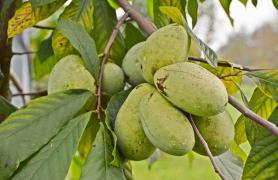
There are certain children’s classics that every kid should read. My list started with the children’s picture book The Biggest Bear by Lynd Ward. Other favorites included Black Beauty by Anna Sewell, Old Yeller by Fred Gipson, and Where the Red Fern Grows by Wilson Rawls.
Now we have come to the number one classic on my list — Charlotte’s Web by E.B. White. Who doesn’t love the story of a spider that saved a pig’s life? When you say it that way, it doesn’t sound like much of a classic does it? But it is a great story, especially for spider lovers. I could spend this entire article on the background of how this classic was written, but I wouldn’t get to talk about Charlotte’s cousin, Missouri’s spotted orbweaver, Neoscona crucifera.
Charlotte is Born
One October, E.B. White was watching a barn spider on his farm spin a web and he became fascinated with it. As he watched it for several days, she spun an egg sack and deposited her eggs into it and later died. When he returned home from his farm, he took the egg sack with him. He was so fascinated by the spider and later the little ones spreading webs throughout his house he asked William Gertsch of the Museum of Natural History to identify the spider. Gertsch identified the barn orbweaver as Araneus cavaticus.
When Charlotte and Wilbur meet in his tale Charlotte’s Web, she gives her name as Charlotte A. Cavatica. Do you see what the author did with her name? Her scientific name is Araneus cavaticus.
Charlotte was born.
Charlotte’s Missouri Cousin
Charlotte was created based on an orbweaver from the family Araneidae. This family is very large, with over 3,000 species worldwide and about 160 species in the United States. Missouri is blessed with about 50 orbweavers. Many orbweavers are large and colorful, and Missouri’s species are no exception. Examples include two garden spiders, the yellow and banded, the marbled orbweaver, and our spotted orbweaver.
Although Missouri doesn’t have A. cavaticus, we have another orbweaver that takes its place — the arboreal orbweaver, also known as the spotted orbweaver or our barn spider. Neoscona crucifera takes the stage in late summer and early fall.
Unlike our large garden spiders, it’s a spider with many different colors. It varies from gray to burnt orange with little or no patterns on its abdomen. Like almost all spiders, especially orbweavers, the females get all the attention. Their bodies are typically much larger (3/8 to ½ inch) and stay in the webs for their entire adult life unless displaced by predators or humans. Males are smaller (¼ to 3/8 inch) and mature much earlier in the year, leaving their web upon becoming sexually mature and seeking out females for mating. Sometimes they can be found waiting patiently next to a female web prepared to mate upon the readiness of the female. An impatient male may just add to the nutritional value of the female if he jumps the gun.
Once the female mates, she lays up to 1,000 eggs and spins a yellow silken sack around the eggs. The size and number of eggs is dependent on the mother’s reproductive health at the time of egg laying and this egg sack could be ¼ to ½ inch in size. She then conceals that sack in a curled leaf, under the eve of a porch or wherever she can find a hiding place. She finishes out her life watching over the egg sack, dying around the first frost. The eggs will remain in the sack until spring when they work their way out and, like Charlotte’s little ones, balloon away to start their life journey.
Life of Missouri’s “Charlotte”
Missouri’s spotted orbweavers’ preferred habitat is moist deciduous forests and woodlands, but they have adapted well around farms, urban areas, homes, and outbuildings. These adopted socialization patterns serve the spider well.
In their natural habitat, these fall maturing spiders must build their webs in areas where they can maximize their capture rate to maintain reproductive health and vigor. This maximization must be weighed against exposure to their top predators, birds and mud daubers. Young spiders tend to build their webs in the evening hours, hunt through the night, and tear down their webs in the early morning hours before predators are active. They then hide in a leaf of a tree, up against the bark or anywhere a crack is available. Adult females will do the same as long as food is readily available during the nighttime hours.
As the summer draws to an end and winter approaches, available food starts to diminish and females may need to hunt around the clock, exposing her to more predators. Life is dangerous in the natural world.
Like many other animals, these spiders have adapted well to encroachment on their habitat. We seem to have more encounters with them as they are attracted to our houses, outbuildings, and barns. They are drawn to things that increase insect numbers, including gardening, barn lots, and street or porch lights. While there is an increase in food availability, there is also an improved level of security for these spiders. Our structures add a new level of obstacles for predators to overcome, increasing their overall survivability. Add to this the increased number of insects and their improved reproductive health, their overall population numbers increase, adding opportunities and hours to the watching enjoyment.
The Un-Charlotte
During the cool fall evenings as you are sitting on the porch, take time to watch the spider in the corner build her beautiful orb web and prepare for her night. She won’t speak to you or leave you a message that says SOME PIG like Charlotte did in the book, but her silent gracefulness is relaxing.
Then, when she has completed her web and you retreat to your bed, leave the light on for your new friend on the porch. She will appreciate it as she hunts for food.
E.B. White was asked about the spider in the barn that he so aptly named Charlotte, and this is what he said, “As for Charlotte herself, I had never paid much attention to spiders until a few years ago. Once you begin watching spiders, you haven’t time for much else — the world is really loaded with them.”












Also In This Issue

Choose your destination and get hooked on fishing.

Not always easy to find, but well worth the search
And More...
This Issue's Staff
Editor - Angie Daly Morfeld
Associate Editor - Larry Archer
Photography Editor - Cliff White
Staff Writer - Kristie Hilgedick
Staff Writer - Joe Jerek
Staff Writer – Dianne Van Dien
Designer - Shawn Carey
Designer - Marci Porter
Photographer - Noppadol Paothong
Photographer - David Stonner
Circulation Manager - Laura Scheuler






















